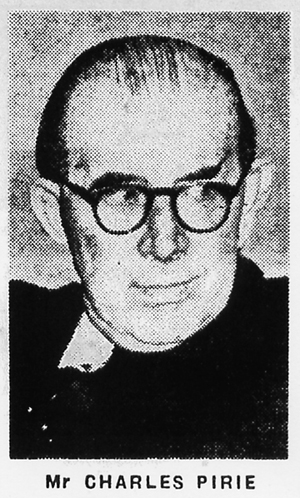
|
|
|
Charles Pirie
8 January 1897 - 3 February 1960
Charles Pirie Was not an outstandingly strong player, but he made a strong impression on the development of chess in Aberdeen and area.
He was born at 259 Union Grove, Aberdeen on 8 January, 1897, the son of William P. Pirie, a fitter.
After regular schooling, he attended the University of Aberdeen, graduating MA in 1920. ( He appeared in the "University of Aberdeen Roll of Service in the Great War 1914 to 1919", published in 1921 and edited by Mabel Allardyce.)
He became a teacher, first in a primary school in Gamrie, Banffshire, then in the Middle School in Aberdeen, where he taught mathematics and science.
He married Margaret Jane Gordon on 28 December 1925.
In 1944, after twenty years at the Middle School, he was promoted to Headmaster of Causewayend School in Aberdeen. He retired from this post in 1958, due to ill health, and died in Aberdeen on 3 February, 1960. His address at the time was 53 Forbesfield Road. He was a widower, and was survived by two daughters.
CHESS
Pirie had a long involvement with the Bon Accord Chess Club in Aberdeen, contributing to the success of that club by his encouragement of young players, and his ability to promote chess. For many years he contributed the Chess Notes to The Press and Journal [Aberdeen]. He also was involved with international correspondence chess.In 1933, Pirie was a member of the Bon Accord team that captured the Spens Cup (the club also won in 1946).
In 1937, Pirie was selected to be the reserve on the Scottish team for the Stockholm Olympiad. This was rather a baptism of fire for someone lacking in experience of high-level play. He played ten games, scoring only one solitary draw.
Pirie was one of the organisers of the 1939 Scottish championship, probably the strongest ever held up to that point. It was won by the American student, Max Pavey, but also included JM Aitken, William Winter, who was British Champion in 1935 and 1936, and RF Combe, a later British champion.
In 1946, on March 30, Pirie played for Scotland in a match against the Northern Counties Chess Union in Carlisle.
GAMES
Pirie - Dr J.M. Aitken [D52]
Richardson Cup, 1937
Notes by Dr Aitken1.d4 Nf6 2.c4 e6 3.Nc3 d5 4.Nf3 Nbd7 5.Bg5 c6 6.e3 Qa5 7.Bxf6 Nxf6 8.Nd2 Bb4 9.Qc2 0-0 10.Be2 Re8 11.0-0 e5 12.dxe5 Rxe5 13.cxd5 cxd5 Perhaps 13...Bxc3 is better. If then 14.Nc4 Qxd5 with a good game for Black. 14.Nb3 Qc7 15.Nd4 Bxc3 Black's strategical idea is to weaken the pawns and control the c-file. I thought White's last move, to counter this, should have been 15.Rac1 but, as played, there is Nb5 and Qxc3 to be considered. 16.Rac1 Ne4 17.bxc3 White falls in with Black's desire. If, however 17.f3 Bxd4 sacrifices the Black Queen for a winning advantage. Thus:- 18.Qxc7 Bxe3+ 19.Rf2 Bxf2+ 20.Kf1 Re8 21.fxe4 Bb6 17...Bd7 18.Qb2 Nd6 19.Rc2 Rc8 20.Rb1 b5 Not 20...a6 first because of 21.Qb6 The pawn on b5 cannot be taken, and Black's advantage on the Q side is clear. 21.Qc1 Qa5 22.Rb3 a6 23.Bf3 f6 24.Qd1 Be8 25.Ne2 Bf7 26.Rd2 Ne4 27.Bxe4 dxe4 28.Rbb2 Bc4 Forcing the win of a pawn, but too hastily assuming this would decide the game. 29.Rd7! Bxe2 30.Rxe2 Qxc3 31.Red2 Qa3 Now I found myself in a difficult position. I rejected 31...Qc1 32.Rd8+ Kf7 33.R2d7+ etc., as that would at least draw for White. As played, I foresaw White's next move, but overlooked the force of his 33rd move. 32.Rxg7+ Kh8 33.Ra7! Ree8 Forced. White can now also draw with 34.Rxh7+. 34.Rdd7 Rc1 35.Rxh7+ ½-½
Cozens, in The Lost Olympiad, introduces the next game as follows:
The game between de Groot and Pirie was an affair of crowded manoeuvring, the first pair of pawns going at move 22, and the second pair not until move 45. The inexperienced Pirie was not able to make use of his half-open h-file, and eventually de Groot managed to build up and use it himself. Pirie manoeuvred warily behind the lines, but collapsed just on the 50 move adjournment.A. de Groot - Pirie [E18]
Stockholm Olympiad 1937 (Holland - Scotland, Round 6)1.d4 Nf6 2.c4 e6 3.Nf3 b6 4.g3 Bb7 5.Bg2 Be7 6.0-0 0-0 7.Nc3 c5 8.d5 d6 9.e4 e5 10.b3 Nbd7 11.Ne1 Ne8 12.Nd3 Bf6 13.Bb2 g6 14.Qd2 Bg7 15.Ne2 Qe7 16.Rae1 f6 17.f4 Nc7 18.Nc3 a6 19.a4 a5 20.Bc1 Rae8 21.f5 Kf7 22.fxg6+ hxg6 23.g4 Rh8 24.Qf2 Reg8 25.Bg5 Ke8 26.Bh4 g5 27.Bg3 Nf8 28.Nd1 Bc8 29.Ne3 Ng6 30.Nf5 Bxf5 31.exf5 Nh4 32.Re3 Nxg2 33.Kxg2 Kd7 34.Kf3 Qf7 35.Ke4 Re8 36.Qg2 Qg8 37.h3 Bh6 38.Rh1 Qf7 39.Ree1 Qg7 40.Rh2 Rh7 41.Reh1 Reh8 42.Nf2 Ne8 43.Kd3 Kd8 44.Ne4 Qf7 45.h4! gxh4 46.Rxh4 Kd7? 47.Qh3! Qg7 48.Bf2 Nc7 49.g5 Qf7 50.g6 Qg8 51.Nxf6+ 1-0
Sources:
Gail Murdoch, Secretary, Aberdeen University Alumnus Association.
Morag Penny, Assistant Reference & Local Studies Librarian, Aberdeen City Council.
The Lost Olympiad, by W.H. Cozens. BCM Quarterly No. 22, 1985.
Chess Olympiads, by Árpád Földeák. Corvina Press, 1969.
BCM 1946, p 150
Evening Express (Aberdeen), 3rd february, 1960.Alan McGowan
Historian, Chess Scotland
